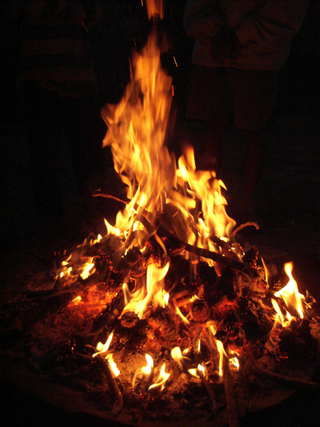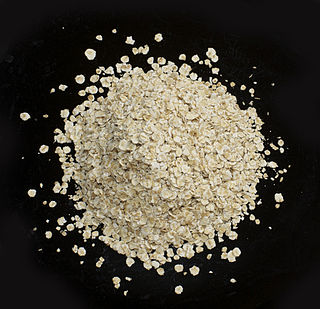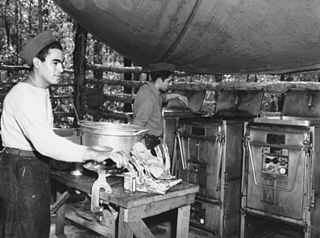
A kitchen is a room or part of a room used for cooking and food preparation in a dwelling or in a commercial establishment. A modern middle-class residential kitchen is typically equipped with a stove, a sink with hot and cold running water, a refrigerator, and worktops and kitchen cabinets arranged according to a modular design. Many households have a microwave oven, a dishwasher, and other electric appliances. The main functions of a kitchen are to store, prepare and cook food. The room or area may also be used for dining, entertaining and laundry. The design and construction of kitchens is a huge market all over the world.

A campfire is a fire at a campsite that provides light and warmth, and heat for cooking. It can also serve as a beacon, and an insect and predator deterrent. Established campgrounds often provide a stone or steel fire ring for safety. Campfires are a popular feature of camping. At summer camps, the word campfire often refers to an event at which there is a fire. Some camps refer to the fire itself as a campfire.

Oatmeal is a preparation of oats that have been de-husked, steamed, and flattened, or a coarse flour of hulled oat grains (groats) that have either been milled (ground), rolled, or steel-cut. Ground oats are also called white oats. Steel-cut oats are known as coarse oatmeal, Irish oatmeal, or pinhead oats. Rolled oats were traditionally thick old-fashioned oats, but can be made thinner or smaller, and may be categorized as quick oatmeal or instant oatmeal depending on the cooking time required, which is determined by the size of the oats and the amount of precooking.

The Meal, Ready-to-Eat (MRE) is a self-contained individual United States military ration used by the United States Armed Forces and Department of Defense. It is intended for use by American service members in combat or field conditions where other food is not available. MREs have also been distributed to civilians as humanitarian daily rations during natural disasters and wars.

Camping is a form of outdoor recreation or outdoor education involving overnight stays with a basic temporary shelter such as a tent. Camping can also include a recreational vehicle, sheltered cabins, a permanent tent, a shelter such as a bivy or tarp, or no shelter at all. Typically, participants leave developed areas to spend time outdoors, in pursuit of activities providing them enjoyment or an educational experience. Spending the night away from home distinguishes camping from day-tripping, picnicking, and other outdoor activities.

A portable stove is a cooking stove specially designed to be portable and lightweight, used in camping, picnicking, backpacking, or other use in remote locations where an easily transportable means of cooking or heating is needed. Portable stoves can be used in diverse situations, such as for outdoor food service and catering and in field hospitals.

Outdoor cooking is the preparation of food in the outdoors. A significant body of techniques and specialized equipment exists for it, traditionally associated with nomadic cultures such as the Berbers of North Africa, the Arab Bedouins, the Plains Indians, pioneers in North America, and indigenous tribes in South America. These methods have been refined in modern times for use during recreational outdoors pursuits, by campers and backpackers.

Backpacking is the outdoor recreation of carrying gear on one's back while hiking for more than a day. It is often an extended journey and may involve camping outdoors. In North America, tenting is common, where simple shelters and mountain huts, widely found in Europe, are rare. In New Zealand, hiking is called tramping, and tents are used alongside a nationwide network of huts. Hill walking is equivalent in Britain, though backpackers make use of a variety of accommodation, in addition to camping. Backpackers use simple huts in South Africa. Trekking and bushwalking are other words used to describe such multi-day trips.

Freeze drying, also known as lyophilization or cryodesiccation, is a low temperature dehydration process that involves freezing the product and lowering pressure, removing the ice by sublimation. This is in contrast to dehydration by most conventional methods that evaporate water using heat.

United States military ration refers to the military rations provided to sustain United States Armed Forces service members, including field rations and garrison rations, and the military nutrition research conducted in relation to military food. U.S. military rations are often made for quick distribution, preparation, and eating in the field and tend to have long storage times in adverse conditions due to being thickly packaged or shelf-stable.

A field ration is a type of prepackaged military ration designed to be easily and quickly prepared and consumed in the field, in combat, at the front line, or where eating facilities are otherwise unavailable. Field rations are primarily used by military forces, though they are also sometimes distributed to civilians as part of humanitarian aid and emergency management. They differ from garrison rations and field kitchen provisions, which are intended for where proper meals can be supplied and prepared with relative ease and safety, such as in the rear where logistics are steady and fresh food can be supplied. They are similar to, but distinct from, other purpose-designed long-lasting types of food or rations such as emergency rations, humanitarian daily rations, and camping food.

The Individual Meal Pack or IMP is one type of field ration used by the Canadian Forces. The IMP is designed so that a continuous diet provides all the nutrition needed to sustain a service-person in the field. The IMP meets Canada's nutrition requirements, with the exception of calcium and folic acid, which are not significant if the consumption period of rations is less than 30 (consecutive) days. IMPs provide 1,200–1,400 calories (5.0–5.9 MJ) per meal.

The following outline is provided as an overview of and topical guide to food preparation:

Ultralight backpacking is a style of lightweight backpacking that emphasizes carrying the lightest and least amount of gear. While no technical standards exist, some hikers consider "ultralight" to mean an initial base weight of less than 4.5 kg (9.9 lb). Base weight is the weight of a fully loaded backpack at the start of a trip, excluding worn weight and consumables such as food, water, and fuel. Base weight can be lowered by reducing the weight of individual items of gear, or by choosing not to carry that gear. Ultralight backpacking is most popular among thru-hikers.
Hiking equipment is the equipment taken on outdoor walking trips. Hiking is usually divided into day-hikes and multiple-day hikes, called backpacking, trekking, and walking tours.
Instant rice is a white rice that is partly precooked and then is dehydrated and packed in a dried form similar in appearance to that of regular white rice. That process allows the product to be later cooked as if it were normal rice but with a typical cooking time of 5 minutes, not the 20–30 minutes needed by white rice. This process was invented by Ataullah K. Ozai‐Durrani in 1939 and mass-marketed by General Foods starting in 1946 as Minute Rice, which is still made.

The B-ration was a United States military ration consisting of packaged and preserved food intended to be prepared in field kitchens by cooks. Its modern successor is the Unitized Group Ration – M (UGR-M), which combines multiple types of rations, including the B-ration, under one unified system.

This is a categorically-organized list of foods. Food is any substance consumed to provide nutritional support for the body. It is produced either by plants, animals, or fungi, and contains essential nutrients, such as carbohydrates, fats, proteins, vitamins, or minerals. The substance is ingested by an organism and assimilated by the organism's cells in an effort to produce energy, maintain life, or stimulate growth.





















